There’s a way to create impeccably targeted personalized ads that comply with pretty much any privacy law.
What’s more, you can increase your conversions while lowering your costs by utilizing that.
Let’s talk about the game-changing Google Ad Customizers.
What is “Google Ad Customizers”?
Ad customizers provide features such as keyword insertion and countdown timers, allowing you to incorporate dynamic content directly into your ads. This not only saves time in managing Google Ads but also enhances campaign performance.
Importance of Personalization: In a cookieless digital landscape, personalization becomes crucial for effectively reaching the right audience. Ad customizers enable this personalization by allowing dynamic content insertion.
Long-Term Cost Savings: Ad customizers offer cost savings in the long run. You won’t need to constantly make adjustments to prices, products, landing pages, or sales funnels. Instead, you can create dynamic ads that adapt to changing events, promotions, and target audiences.
Efficiency and Sustainability: Creating new campaigns with fresh content is time-consuming and challenging to maintain. Ad customizers frontload the work, making it easier to stay updated with evolving factors. Once the configuration is set up, you can run ads continuously, requiring only periodic maintenance.
Excellent ROI: Ad customizers provide an excellent return on investment (ROI) for the initial effort invested in setting up dynamic ads.
How Do Ad Customizers Work?
Ad customizers let you insert dynamic content into your ads, based on various criteria. You can use them for text ads and responsive search ads, and customize any part of your ad text except for the URL.
You should note that URL path customization is only supported for responsive search ads business data and location customizers, not for responsive search ads countdown.
Using the ad customizers, you can tailor your ads to the highest level of specificity without violating any privacy regulations or rules with this unique tool. Read on to discover how to optimize & get the most out of Google ad customizers.
What Are the Types of Google Ad Customizers
Google ad customizers allow you to customize & improve your ads with a bunch of different options.
Here are the customizers that don’t need a data feed file:
Dynamic Keyword Insertion Customizers: Incorporate relevant keywords into your ad.
Countdown Customizers: Add a countdown timer to create urgency.
IF Function Customizers: Display different text based on specific conditions.
Parameter Customizers: Use parameters for tailored messaging.
- Sales for holidays and festivities
- Specific targeting in an extensive product catalogue
- Location-specific services, availability and pricing
- Targeting specific audience groups
- Hyper-specialized ads for tailored goals.
- Enhanced ad relevance and click-through rate (CTR) - one of the top 3 KPIs for Google Ads - by matching it with the search query. This way, the ad reflects the user’s intent more accurately
- Easy scaling by creating one customizer that makes a multitude of variations.
- Time, as you can create hundreds of variations of your ad text with just one ad copy and a data source. You don’t have to manually update your ads for each product, keyword, location, or other criteria.
- More relevant ads since you can customize your ads based on various factors, such as the user’s search query, device, location, audience list, time of day, and more.
- On the Campaigns page, click the Columns icon.
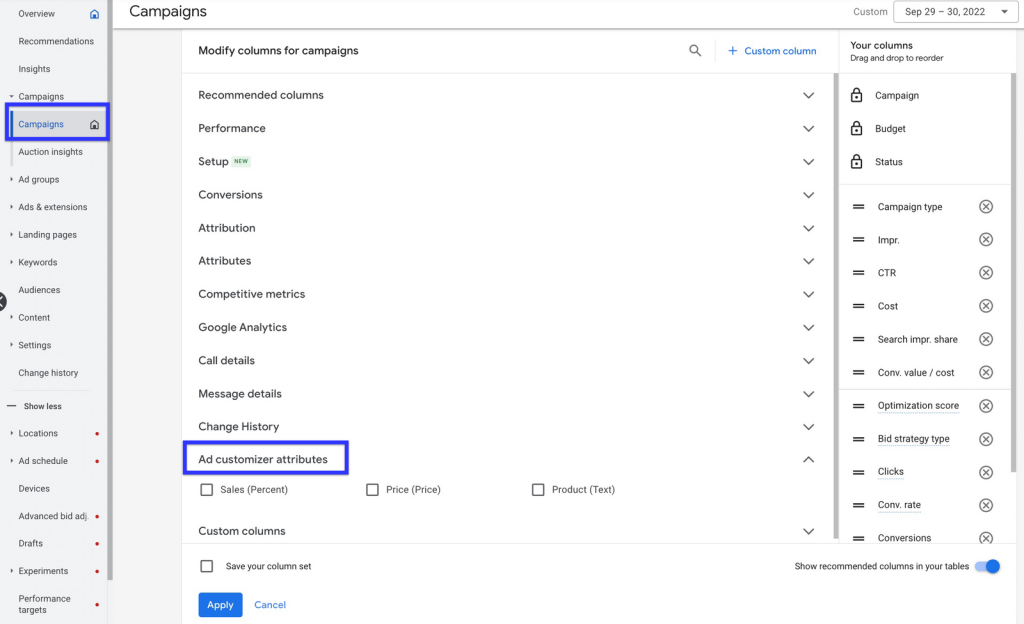
- In Ad Customizer Attributes, find the one you’d like to edit and click the box.
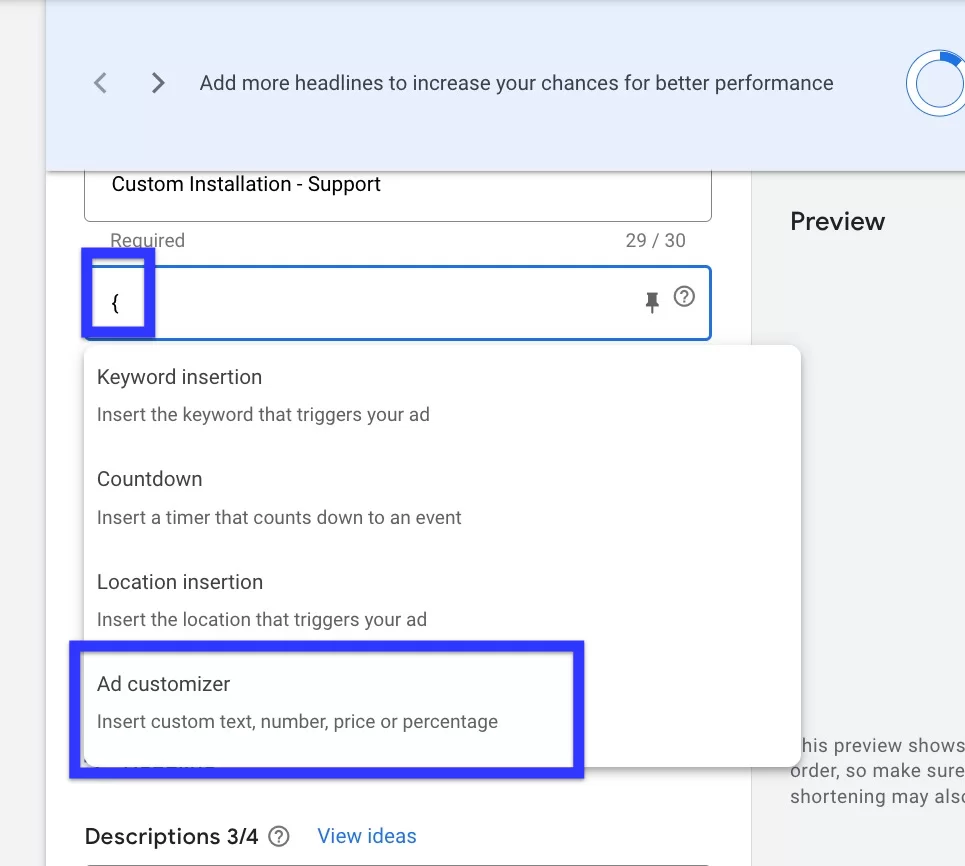 - Click Apply. The attribute will appear as a column for all Search campaigns.
- Select Use Custom Value and edit the attribute content.
- Click Apply. The attribute will appear as a column for all Search campaigns.
- Select Use Custom Value and edit the attribute content. - Enter a curly bracket “{” for the section you want your customizer to be in.
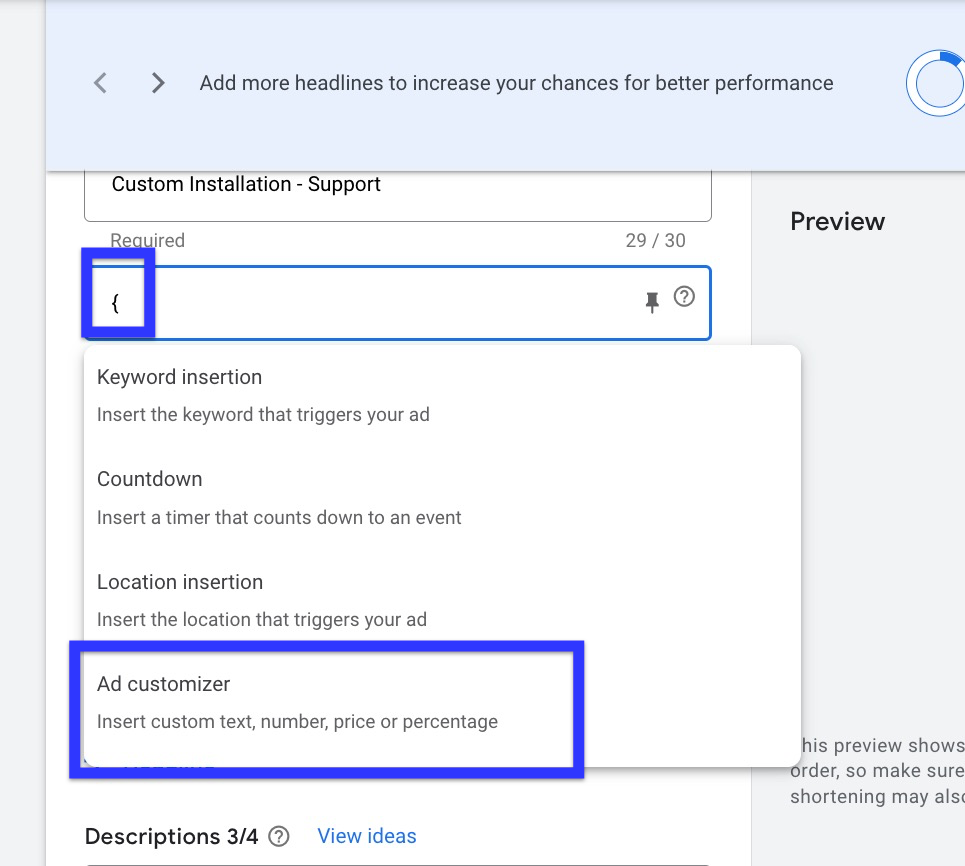
- Select Ad Customizer from the dropdown menu and pick your attribute.
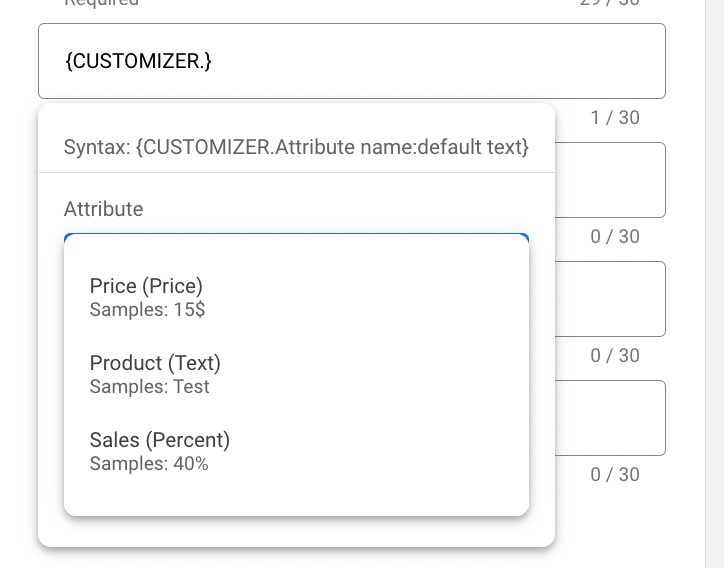 - Enter a default value for the customizer. When nothing triggers it, this text will show. Click Apply.
- Enter a default value for the customizer. When nothing triggers it, this text will show. Click Apply.
These tools allow you to dynamically integrate elements like keywords, prices, countdowns, and IF functions into your ad text.
Dynamic keyword insertion customizers
Dynamic keyword insertion allows you to create highly relevant ads by matching them with the exact keywords used in search queries.
Consider this scenario: your ad group targets keywords related to “coffee beans”. By implementing dynamic keyword insertion, your ads can mirror the specific keywords that people use in their searches.
For instance, if someone searches for “arabica coffee beans” they will be presented with an ad headlined ‘“arabica Coffee Beans” Similarly, a search for ‘”robusta coffee beans” will trigger an ad that reads “Robusta Coffee Beans”.
This method ensures that your ads are precisely aligned with the user’s search intent.
Countdown customizers
If you make use of countdown customizers, your search ads will display the time remaining until a certain date or time. These customizers are ideal for creating urgency and excitement for your offers, discounts, and occasions, such as Black Friday.
IF function customizers
The IF function ad customizers in Google Ads enable you to display distinct ads to different users, based on two key criteria: device type and audience list.
With the device type option, you can tailor your ads according to the user’s device, such as mobile or desktop.
The audience list option allows for ad customization based on the user’s previous interactions with your business, like targeting previous buyers, assuming you have a compiled list of such customers.
Additionally, alongside these customizers, which don’t require any data feed file, Google Ads also offers parameter customizers for further ad personalization.
Parameter customizers
Parameter customizers in Google Ads provide a versatile way to modify various aspects of your ads. By utilizing a data feed file, you can instruct Google Ads on the specific elements you wish to change, such as products, prices, stock availability, and more. These customizers use your data feed file to dynamically display different values for the aspects you choose to alter in your ads.
Scenario: Online Fashion Store
Imagine you run an online fashion store that sells a wide variety of stylish clothing, accessories, and shoes. You want your ads to reflect the most up-to-date information about these products, such as prices, availability, and special offers.
Step 1: Creating a Product Catalog
First, you need to create a product catalog that includes all the important details about your products. This catalog should have columns for product names, prices, stock status, and any special promotions. For example, the catalog might have entries like:
Product: Embroidered Denim Jacket Price: $149 Stock: Limited Promotion: Free shipping on orders over $100
Step 2: Using Parameter Customizers
Use parameter customizers in your Google Ads to automatically add real-time product details from the product catalog to your ads. Define custom parameters for each aspect you want to highlight in your ads:
{Product} for the product name {Price} for the current price {Stock} for stock availability {Promotion} for any ongoing offers
Step 3: Dynamic Ads in Action
Now, when someone searches for an “Embroidered Denim Jacket,” your ad will automatically update with the latest information from your product catalog. The ad might look like this:
“Upgrade your style with the Embroidered Denim Jacket, now only $149! Hurry, limited stock available! Get free shipping on orders over $100.”
This dynamic update ensures that your ads are always accurate and relevant, which can improve the user experience and potentially make your advertising campaigns more effective.
Best Scenarios to Use Ad Customizers
Here is a short list of the best scenarios to make use of Ad Customizers. So, you can utilize them when you have:
If you set up your customizers the right way and optimize them according to your business’ needs,you can get more relevant & personalized ads that can improve your campaign performance and get better results.
The Benefits of Ad Customizers for Advertisers
As customizers are a powerful feature that can help you create more effective and relevant ads for your target audience, they provide you with:
With ad customizers, you can tailor your responsive search ad campaigns into an ad your potential clients need.
If you still have text or expanded text campaigns, Google has terrible news for you as you won’t be able to create or edit ad customizers for expanded text ads because the creation of new expanded text ads will not be supported.
How to Implement Ad Customizers for Responsive Search Ads
-
- Open your business data & create your ad customizer.
- When creating, define the ad attributes so you can categorize the dynamic text.
- Enter attribute details and assign values. This is what’ll appear.
- Customize your ad text (insert the customizer in your responsive search ad).
There’s a lot to unpack in these steps. Let’s start with the first one.
Adding business data can be challenging. But once you get the hang of it after a few campaigns, setup will get quicker.
How to Set Up Your Business Data Feeds
Click the Tools icon on Google Ads and find Business Data under Setup.
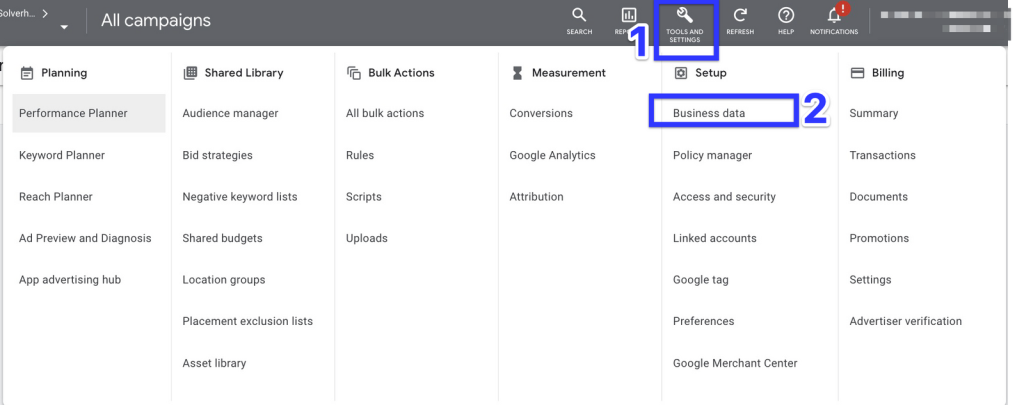
Click the plus button to add the data feed.
For this tutorial, we’ll go with Ad customizers. Give a unique name to your data source.
Click Choose File and upload your files. The size limit for.csv and.tsv files is 500MB and 50MB for other file types.
Double-check your upload: Under the Actions column, you can Download results if the upload was successful or Download Errors to determine any mistakes.
Ad Customizer Setup
Now that we have completed the business data, we can get on with the ad customizer setup. The first step, find said business data.
In your Google Ads account, find the Business Data.

Choose Ad customizer attributes and click the + button.
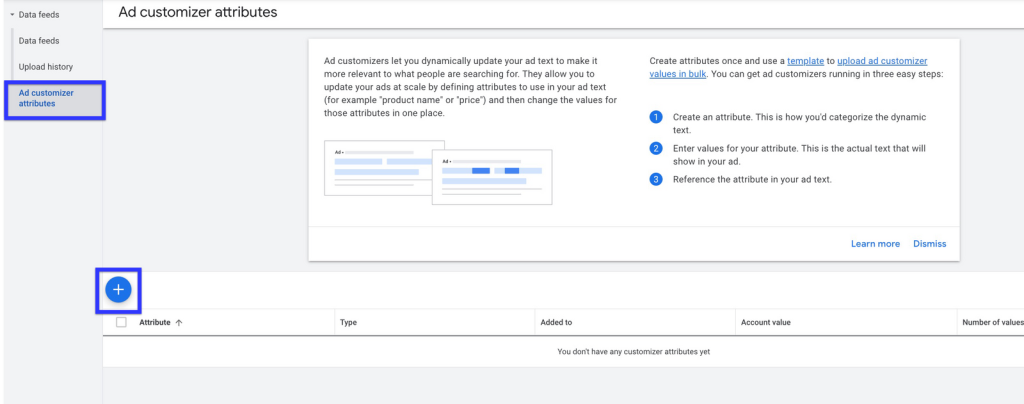
The second step is the actual customization. You need to choose specifics for the ad. These details are called “attributes”; once you set them, you can use them across the entire account.
If you have time to spare – or if you are doing it for the first time, choose attributes individually. If not, feel free to upload it in bulk from a spreadsheet.
How to create individual attributes:
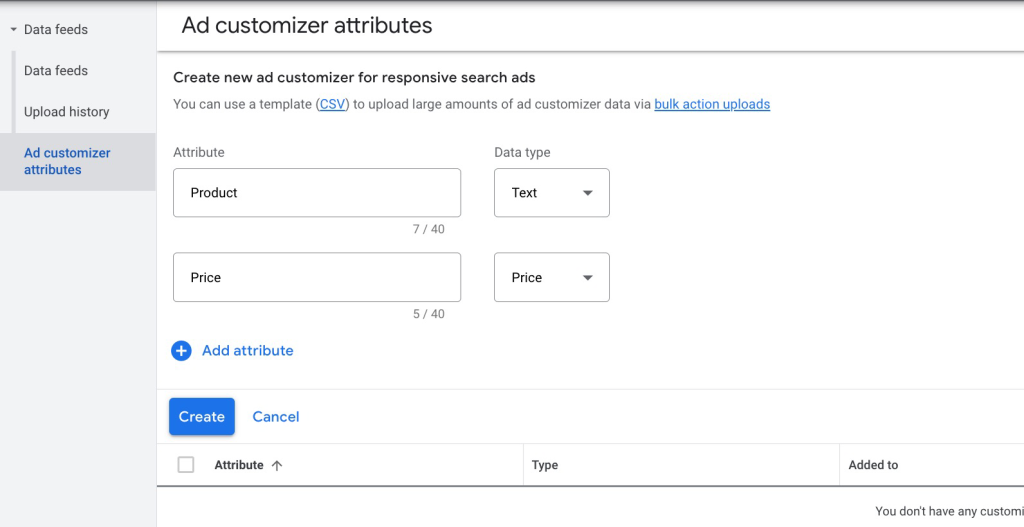
Name the Attribute field with the content you want to customize. (ex. Product.) ps. Don’t use any symbols or punctuation. Select your Data Type. Common data types include Price, Text, Number, and Percent. Working on a sale campaign? Go with the per cent.
If you made a mistake, find Business Data. Locate the customizer you want to delete and click the box next. After, you can click Edit and Remove.
How to upload attributes from a spreadsheet:

-
- Click the tool icon. Under Bulk Actions, find Upload.
- Click the plus button and download a template. It’s essential to include the exact data in the template. Otherwise, your setup might go wrong. Please leave rows 8 through 12 under columns A through C in the template blank.
- Select the source of your file and start creating attributes in the relevant columns.
- These attributes need values. Enter those in the values columns.
Schedule a Bulk upload:
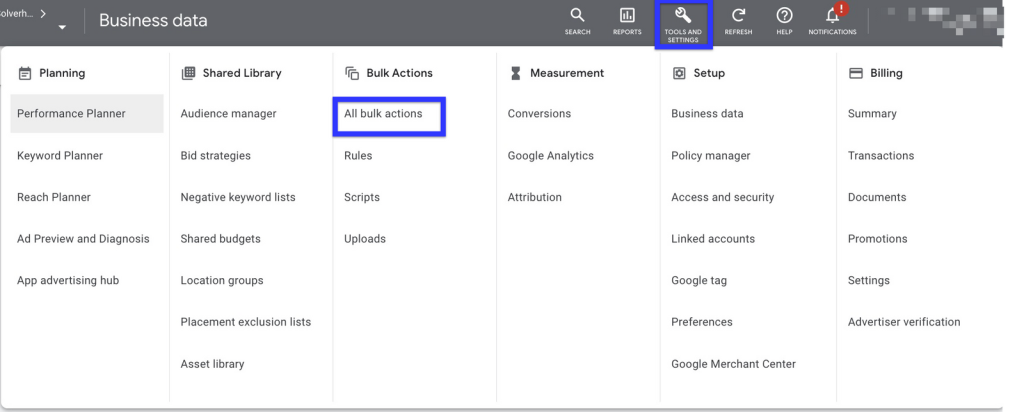
-
- Click the tool icon and find All Bulk Actions under Bulk Actions.
- Click Uploads and find Schedules. Click + button.
- Select your Source. After uploading your file, determine the Frequency and Time for the bulk upload.
You’ve created attributes. Now what?
Enter attribute details and assign values
Now it’s time to create the content for your ad. This is the text, price or number that will appear. You can add all of those here, but the content will still have to go through the ads approval process.
Update the Account Value column. This way, you’ll set up details for the entire account.
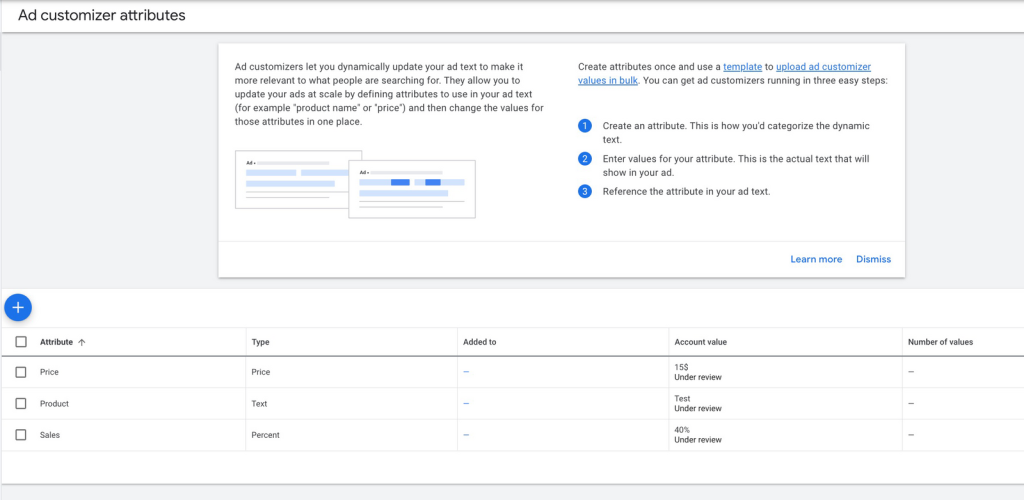
Click the Pencil button. Enter your text and save.
If you want to customize this content for various campaigns (similar to ad groups and keywords)
Your customizer is created. Now we get to use it to customize your ads. Let’s break down how exactly you do it.
-
- In Ads & Extensions, select Ads.
- Click the plus button and choose Responsive search ad.
Conclusion: All About Google Ad Customizers
In short, ad customizers offer a versatile toolkit for optimizing your Google Ads campaigns.
By adding dynamic content directly into your ads, you can save time, increase conversions, and enhance your overall campaign performance.
With personalization emerging as a key factor in effective marketing, customizers can help you reach the right audience without the need to constantly modify prices, products, landing pages, or sales funnels.
Instead of crafting new campaigns from scratch every time, you can create a single customizer that generates a multitude of variations, allowing you to keep up with special occasions, sales, and expanding audiences.
The return on investment (ROI) for the initial effort is exceptional, as you can run these ads indefinitely with ongoing maintenance.
Leveraging ad customizers empowers you to deliver personalized experiences to your target audience, optimize your ad campaigns, and achieve better results & better return on ad spend (ROAS). By embracing this innovative approach, you can stay ahead of the competition and increase the potential of your advertising efforts.

































